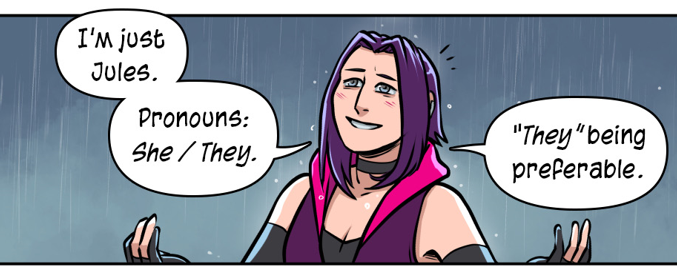With Jules, the She/They in my comic, I handled it like this:
When Rekki speaks about them, she uses "they" pronouns, because Rekki has known Jules for years, and knows Jules prefers "they".
When Subo sees Jules, who presents femme, for the first time, he talks about them with "she" pronouns, and Rekki doesn't correct him, because she's just met Subo, doesn't expect them to interact much, so knows Jules won't really care. BUT, by the following day, Subo has started talking about Jules as "they" because they're friends now, and the reason for this is...
When Jules introduces themselves to people they expect to spend more time around, in this panel, it's the mysterious activist known as Crow...

Jules specifies a preference. So characters that like them or are close to them always use "they" pronouns for Jules.
And when you see stuff about Jules on social media...
You can see details here like: Jules is publicly using a nonbinary knight title "Ser", not "Sir" or "Lady", and also specifies pronouns in their bio.
With Jules, I think they're somebody who generally prefers to be a "they", but can't be bothered constantly explaining to people, so won't fight the odd "she" from a stranger or aquaintance. Plus there's the fact that Jules likes to present quite femme, just as a style choice (because not all nonbinary people feel the need to be visually androgynous. Gender identity and presentation aren't always the same thing), and they get that for some people, that will cause the assumption of "woman", while they'd consider themselves more.... "woman-adjacent". I'm not NB myself, but took a lot of inspiration from a bunch of different NB friends.
The nice thing about this approach is that it's a little forgiving for the people in the audience who don't pick up on it and refer to Jules as a "she", because Errant does have a pretty broad readership beyond people who normally read queer comics. Often like Subo, after getting to know Jules more closely, the readers too start to call them "them". Some of the Nonbinary readers get angry at Jules' brother Urien for calling them his "sister", but Urien is already a huge jerk who treats Jules quite dismissively, so whether a person thinks that's fine, or if it's horrible misgendering a caring person wouldn't do, it still works.